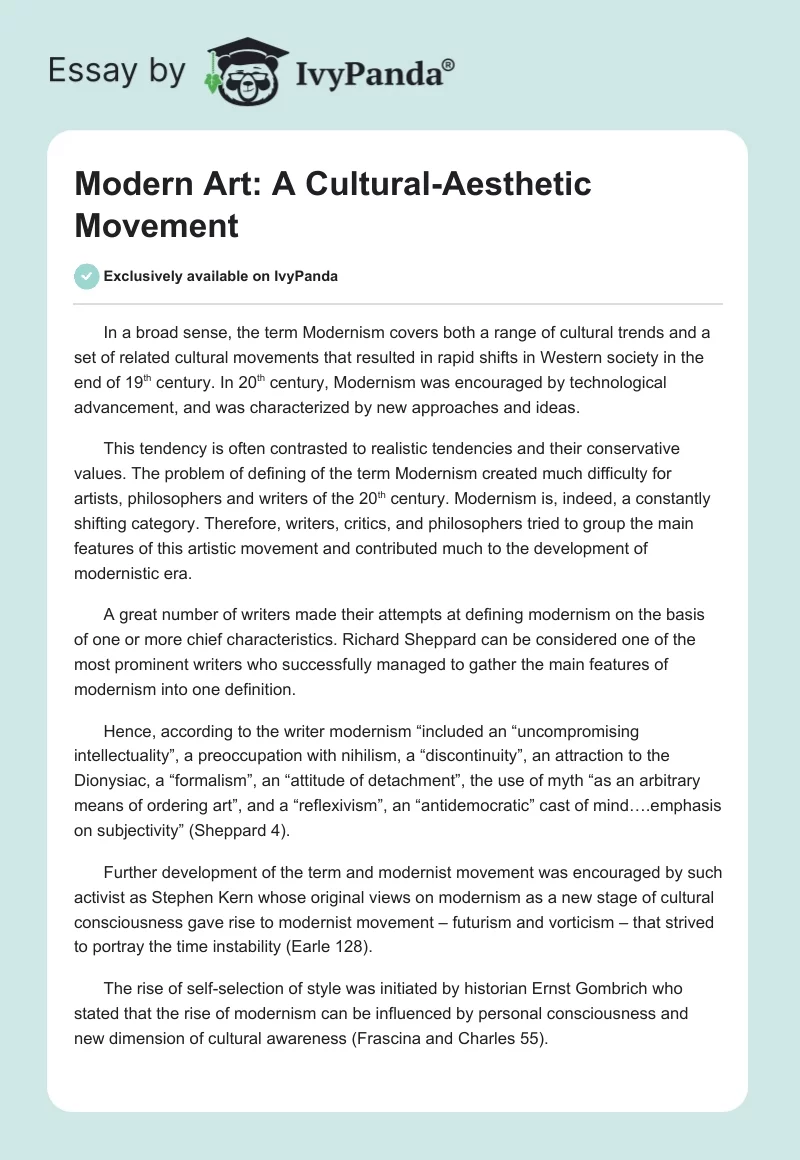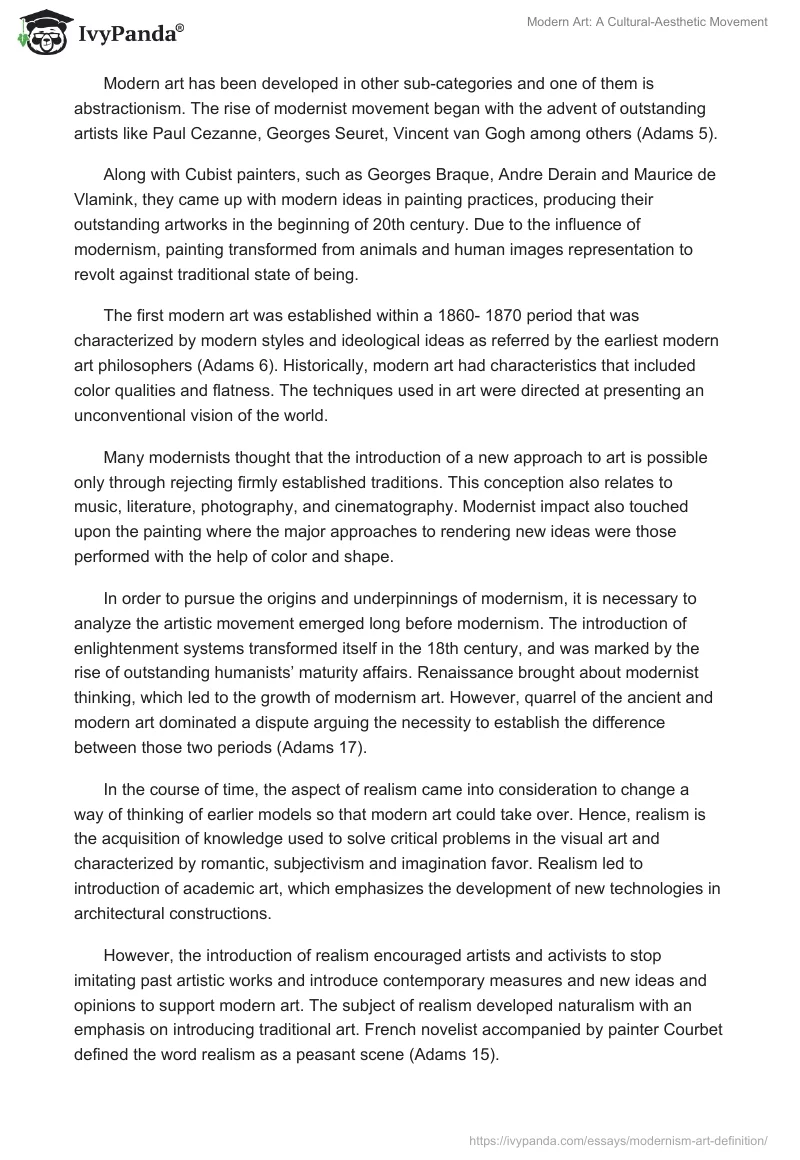In a broad sense, the term Modernism covers both a range of cultural trends and a set of related cultural movements that resulted in rapid shifts in Western society in the end of 19th century. In 20th century, Modernism was encouraged by technological advancement, and was characterized by new approaches and ideas.
This tendency is often contrasted to realistic tendencies and their conservative values. The problem of defining of the term Modernism created much difficulty for artists, philosophers and writers of the 20th century. Modernism is, indeed, a constantly shifting category. Therefore, writers, critics, and philosophers tried to group the main features of this artistic movement and contributed much to the development of modernistic era.
A great number of writers made their attempts at defining modernism on the basis of one or more chief characteristics. Richard Sheppard can be considered one of the most prominent writers who successfully managed to gather the main features of modernism into one definition.
Hence, according to the writer modernism “included an “uncompromising intellectuality”, a preoccupation with nihilism, a “discontinuity”, an attraction to the Dionysiac, a “formalism”, an “attitude of detachment”, the use of myth “as an arbitrary means of ordering art”, and a “reflexivism”, an “antidemocratic” cast of mind….emphasis on subjectivity” (Sheppard 4).
Further development of the term and modernist movement was encouraged by such activist as Stephen Kern whose original views on modernism as a new stage of cultural consciousness gave rise to modernist movement – futurism and vorticism – that strived to portray the time instability (Earle 128).
The rise of self-selection of style was initiated by historian Ernst Gombrich who stated that the rise of modernism can be influenced by personal consciousness and new dimension of cultural awareness (Frascina and Charles 55).
Modern art has been developed in other sub-categories and one of them is abstractionism. The rise of modernist movement began with the advent of outstanding artists like Paul Cezanne, Georges Seuret, Vincent van Gogh among others (Adams 5).
Along with Cubist painters, such as Georges Braque, Andre Derain and Maurice de Vlamink, they came up with modern ideas in painting practices, producing their outstanding artworks in the beginning of 20th century. Due to the influence of modernism, painting transformed from animals and human images representation to revolt against traditional state of being.
The first modern art was established within a 1860- 1870 period that was characterized by modern styles and ideological ideas as referred by the earliest modern art philosophers (Adams 6). Historically, modern art had characteristics that included color qualities and flatness. The techniques used in art were directed at presenting an unconventional vision of the world.
Many modernists thought that the introduction of a new approach to art is possible only through rejecting firmly established traditions. This conception also relates to music, literature, photography, and cinematography. Modernist impact also touched upon the painting where the major approaches to rendering new ideas were those performed with the help of color and shape.
In order to pursue the origins and underpinnings of modernism, it is necessary to analyze the artistic movement emerged long before modernism. The introduction of enlightenment systems transformed itself in the 18th century, and was marked by the rise of outstanding humanists’ maturity affairs. Renaissance brought about modernist thinking, which led to the growth of modernism art. However, quarrel of the ancient and modern art dominated a dispute arguing the necessity to establish the difference between those two periods (Adams 17).
In the course of time, the aspect of realism came into consideration to change a way of thinking of earlier models so that modern art could take over. Hence, realism is the acquisition of knowledge used to solve critical problems in the visual art and characterized by romantic, subjectivism and imagination favor. Realism led to introduction of academic art, which emphasizes the development of new technologies in architectural constructions.
However, the introduction of realism encouraged artists and activists to stop imitating past artistic works and introduce contemporary measures and new ideas and opinions to support modern art. The subject of realism developed naturalism with an emphasis on introducing traditional art. French novelist accompanied by painter Courbet defined the word realism as a peasant scene (Adams 15).
From point of perception, realism was the best motivational aspect that the upcoming models could use to support the growth of modernism. Realism has been widely used since 1840s, focusing on painting and photographic activities as seen from pre-Raphaelite and Millais Ophelia works.
Moreover, it was not only the use of realism that had to be considered for modernism support. Other models had new approaches that also supported the growth of modern art. Earliest models like Kant used this abstract aspect to analyze his artistic works. He believed that abstract represents spiritual deformation that carries entire moral dimensions (Sheppard 5). He added by saying that, this moral dimensions had their own outstanding order virtues, purity and simplicity, which encourage development of new ideas. The philosopher believed that abstract method had a great influence on modern art when used.
Abstractionism is one way of extracting some elements within the context. Artists used this model to make sure that they studied some of the challenging objects and analyze any critical area in the easiest way possible for other people to understand and visualize some elements of abstractionism. Modernism contributed to the development of new dimension in presenting ideas. I also helped to adjust to rapid changes occurred in postwar society. This trend provided new incentives for promoting art.
Postmodernism is the idea of artwork transformation from ancient Greek and Romans perception to modern artwork perception. The influence of modernism led to the provision of postmodernism, which was characterized by pop art, conceptual art, Neo-Expressionism and Feminist from early 1960s (Ozenfant 74). It was an influence provided by Western Europe that led to the collapsing of higher culture and popular culture, creating boundaries between them. However, postmodernism had an influence to the growth of modernism since; it fails to recognize the presence of any single style of art and its transformation. However, we have significant difference between modernism and postmodernism.
As seen from earlier art models, modernists believed that they can discover a lot when they do away with tradition forms of artistic approach. In his old days of music discoveries, Arnold Schoenberg believed that he could do away with traditional tonal harmony, which was termed as the most systematic hierarchical way of music organization (Ozenfant 76).
Through this, he developed his own approach by organizing music sounds using twelve-note rows. Moreover, earlier models like Paul Cezanne and Edward Munich believed that the essential characteristics of art were impressive using color and shapes that portray real vision. Many of these cultural and consumer reactions were the cause of modernism rise (Adams 18).
There was a lot of criticism on the modernism approach that gained its momentum after the World War II. Modern art was opposing tradition ways of representing artwork by creating freedom of expression (Sheppard 4). Artists had freedom to portray their own fresh and new ideas and opinions. The aim of introducing modern art was to establish the simplest way one could understand every aspect in the art gallery.
This modern adoption enabled modernist to combine musical traditions with modernist verses. In this regard, modernism is a transformation that made everyone understand that freedom of feelings and emotion can be revealed in different ways. However, through all these transformation, modernism is regarded as the strongest and persistent artwork (Ozenfant 74).
In conclusion, modernism was a transition stage that changes the approach to conveying artistic ideas. Its foundation was due to literary works and conceptions where such writers as Sheppard and Kern group all features of modernism in a single unity. For its transformation, modernism revolutionary went through hardship and many models that came up with this ideas and opinions faced considerable challenges.
Modern art involves transformation and supporting stages, which include; abstract art, impressionism and postmodernism. Although all definitions of the term are quite diverse, there are some similar features describing this term. In this regard, modernism can be defined as a cultural-aesthetic movement that rejected all conventions and established norms and distorted the underpinnings of realism. Such tendencies were revealed in all cultural spheres.
Works Cited
Adams, Hugh. Modern Painting. United Kingdom: Phaidon Press, 1979. Print.
Earl, David M. Re-covering Modernism: Pulps, paperback and the prejudice of form. US: Ashgate Publishing, 2009. Print.
Frascina, Frank. and Charles, Hugh. Modern Art and Modernism: A Critical Anthology. London: Paul Chapman Publishing, Ltd. 1982. Print.
Ozenfant, Aron. Foundations of Modern Art. New York: Dover Publications. 1952. Print.
Sheppard, Richard. Modernism-dada-postmodernism. US: Northwestern University Press, 2000. Print.


